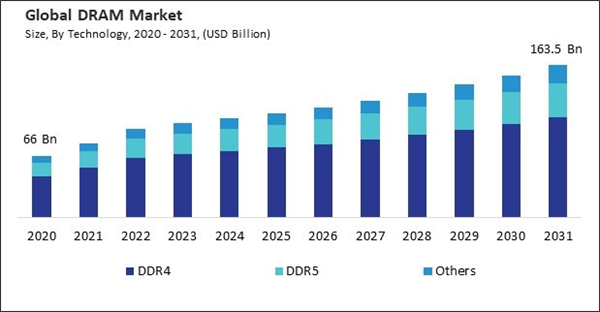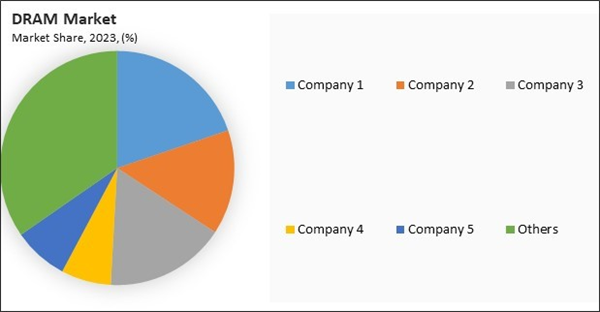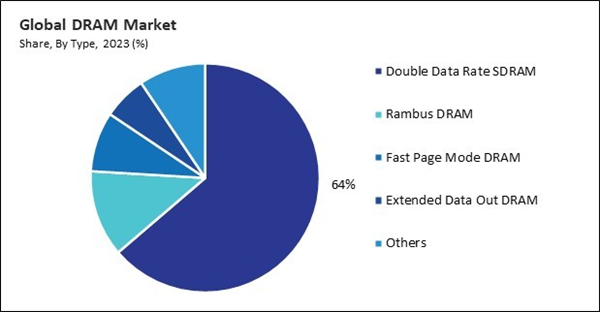The Global DRAM Market size is expected to reach $163.5 billion by 2031, rising at a market growth of 6.3% CAGR during the forecast period.
Modern vehicles increasingly rely on electronic systems for infotainment, advanced driver assistance systems (ADAS), navigation, telematics, and connectivity features. These systems require robust memory solutions like DRAM to ensure smooth operation and quick data access. Consequently, the automotive segment would acquire nearly 11% of the total market share by 2031. According to the International Trade Administration (ITA), the gross domestic product (GDP) of South Africa's automotive industry as a whole was 4.3% in 2021 (2.4% manufacturing and 1.9% retail). Thus, owing to these factors, there will be enhanced demand in the segment.
Cloud computing services have completely changed how companies handle, store, and use data. As infrastructure moves more and more toward the cloud, servers and data centers are becoming increasingly essential to managing the large amounts of data that users create as they access apps, store files, and perform activities on the cloud. Big data analytics also includes handling and examining huge datasets to find insightful patterns and information that can guide corporate choices and spur innovation. Because this RAM provides the high-speed memory needed to quickly access and manipulate massive datasets, it is essential to developing real-time data processing and analytics applications. Therefore, these factors will assist in the expansion of the market. Additionally, The infotainment systems found in modern cars are very advanced and provide many capabilities, including internet access, smartphone integration, multimedia playing, and navigation. Additionally, connected vehicles rely on in-vehicle networking technologies, such as Controller Area Network (CAN), Ethernet, and FlexRay, to facilitate communication between various vehicle systems and components, including sensors, ECUs (electronic control units), and infotainment systems. Therefore, these aspects will pose lucrative growth prospects for the market.
However, establishing a DRAM fabrication facility (fab) requires a massive initial investment, often running into billions of dollars. Moreover, manufacturing benefits significantly from economies of scale, wherein larger production volumes help spread fixed costs over a greater number of units, leading to lower per-unit costs. Hence, owing to these factors, there will be reduced demand in the upcoming years.
The leading players in the market are competing with diverse innovative offerings to remain competitive in the market. The above illustration shows the percentage of revenue shared by some of the leading companies in the market. The leading players of the market are adopting various strategies in order to cater demand coming from the different industries. The key developmental strategies in the market are Acquisitions, and Partnerships & Collaborations.
Modern vehicles increasingly rely on electronic systems for infotainment, advanced driver assistance systems (ADAS), navigation, telematics, and connectivity features. These systems require robust memory solutions like DRAM to ensure smooth operation and quick data access. Consequently, the automotive segment would acquire nearly 11% of the total market share by 2031. According to the International Trade Administration (ITA), the gross domestic product (GDP) of South Africa's automotive industry as a whole was 4.3% in 2021 (2.4% manufacturing and 1.9% retail). Thus, owing to these factors, there will be enhanced demand in the segment.
Cloud computing services have completely changed how companies handle, store, and use data. As infrastructure moves more and more toward the cloud, servers and data centers are becoming increasingly essential to managing the large amounts of data that users create as they access apps, store files, and perform activities on the cloud. Big data analytics also includes handling and examining huge datasets to find insightful patterns and information that can guide corporate choices and spur innovation. Because this RAM provides the high-speed memory needed to quickly access and manipulate massive datasets, it is essential to developing real-time data processing and analytics applications. Therefore, these factors will assist in the expansion of the market. Additionally, The infotainment systems found in modern cars are very advanced and provide many capabilities, including internet access, smartphone integration, multimedia playing, and navigation. Additionally, connected vehicles rely on in-vehicle networking technologies, such as Controller Area Network (CAN), Ethernet, and FlexRay, to facilitate communication between various vehicle systems and components, including sensors, ECUs (electronic control units), and infotainment systems. Therefore, these aspects will pose lucrative growth prospects for the market.
However, establishing a DRAM fabrication facility (fab) requires a massive initial investment, often running into billions of dollars. Moreover, manufacturing benefits significantly from economies of scale, wherein larger production volumes help spread fixed costs over a greater number of units, leading to lower per-unit costs. Hence, owing to these factors, there will be reduced demand in the upcoming years.
The leading players in the market are competing with diverse innovative offerings to remain competitive in the market. The above illustration shows the percentage of revenue shared by some of the leading companies in the market. The leading players of the market are adopting various strategies in order to cater demand coming from the different industries. The key developmental strategies in the market are Acquisitions, and Partnerships & Collaborations.
Technology Outlook
On the basis of technology, the market is divided into DDR4, DDR5, and others. In 2023, the DDR5 segment witnessed a 20% revenue share in the market. DDR5 offers several enhancements over DDR4, including increased bandwidth, higher densities, and improved power efficiency. These improvements are particularly significant in high-performance computing applications, such as data centers, where faster memory access can translate into tangible performance gains. Hence, these aspects will pose lucrative growth prospects for the segment.Type Outlook
Based on type, the market is segmented into double data rate SDRAM, Rambus DRAM, fast page mode DRAM, extended data out DRAM, and others. In 2023, the rambus DRAM segment garnered a 12.2% revenue share in the market. Despite its decline in the mainstream market, RDRAM still finds niche applications in specialized industries where its unique characteristics, such as high bandwidth and low latency, are particularly advantageous. These include areas like high-performance computing, networking equipment, and certain types of graphics processing. Hence, these factors can assist in the growth of the segment.Application Outlook
Based on application, the market is divided into gaming console, PCs/laptops, automotive, mobile phones, and others. In 2023, the PCs/laptops segment witnessed 26.5% revenue share in the market. PCs and laptops are increasingly used for high-performance computing tasks such as video editing, 3D rendering, software development, and data analysis. These tasks require substantial amounts of memory bandwidth and capacity to process large datasets and perform complex computations efficiently. This RAM enables PCs and laptops to handle these demanding workloads with ease, improving productivity and reducing time-to-completion for critical tasks.Regional Outlook
By region, the market is segmented into North America, Europe, Asia Pacific, and LAMEA. The Asia Pacific segment procured 43.5% revenue share in the market in 2023. The demand for chips is rising rapidly in the Asia Pacific region, mostly due to growth in the data center, consumer electronics, automotive, and telecommunications sectors. With the proliferation of smartphones, tablets, and other electronic devices, there's a constant need for memory solutions, which boosts the demand. Hence, these factors can help in the growth of the segment.Recent Strategies Deployed in the Market
- Jan-2024: Micron Technology, Inc. partnered with NAMTECH, a leading semiconductor company specializing in advanced nanotechnology solutions for various industries. Through this partnership, Micron would be able utilize India's robust talent pool in the semiconductor industry, expanding our reach both locally and internationally.
- May-2023: Infineon Technologies AG took over Imagimob AB, a Swedish company specializing in developing edge-AI solutions for wearable and sensor-driven applications. Through this acquisition, Infineon would empower clients to harness AI/ML benefits and expedite product launches by leveraging its sophisticated sensor technology and IoT solutions.
- Apr-2022: Winbond Electronics entered into a partnership with Infineon Technologies, a dominant player in the global semiconductor, microelectronics and IoT solutions market. Under this partnership, the companies announced the expansion of their HYPERRAM product collaboration with the new higher bandwidth HYPERRAM 3.0. The HYPERRAM product range provides compact options to conventional pseudo-SRAM and is perfect for low power, space-constrained IoT applications that need off-chip external RAM. HYPERRAM 3.0 functions at a maximum frequency of 200MHz with a 1.8V operation voltage, which is equal to both HYPERRAM 2.0 and OCTAL xSPI RAM, however, with an improved data-transfer rate of 800MBps - double the rate that was previously present.
- Jun-2021: Kingston Technology entered into a partnership with Digi-Key Electronics, a company that provides the biggest selection of electronic components in stock for immediate shipment. Under this partnership, Digi-Key Electronics aimed to provide a broad range of embedded memory and storage solutions to its customers. The partnership also enabled Kingston to increase its presence in the design engineering community.
- May-2021: Samsung unveiled S2FPD01, S2FPD02, and S2FPC01, the market's foremost integrated power management ICs (PMICs) for the fifth-generation double data rate (DDR5) dual in-line memory module (DIMM). The new PMICs have improved power efficiency and low output ripple voltage, which enables data centers, enterprise servers, and PC applications to fully squeeze their DDR5 performance for incredibly demanding, memory-intensive tasks.
List of Key Companies Profiled
- Samsung Electronics Co., Ltd. (Samsung Group)
- Micron Technology, Inc.
- SK hynix, Inc.
- Transcend Information, Inc.
- Nanya Technology Corporation
- Powerchip Technology Corporation
- Winbond Electronics Corporation
- Infineon Technologies AG
- Kingston Technology Company, Inc.
- Intel Corporation
Market Report Segmentation
By Technology
- DDR4
- DDR5
- Others
By Type
- Double Data Rate SDRAM
- Rambus DRAM
- Fast Page Mode DRAM
- Extended Data Out DRAM
- Others
By Application
- Mobile Phones
- Gaming Console
- Automotive
- PCs/Laptops
- Others
By Geography
- North America
- US
- Canada
- Mexico
- Rest of North America
- Europe
- Germany
- UK
- France
- Russia
- Spain
- Italy
- Rest of Europe
- Asia Pacific
- China
- Japan
- India
- South Korea
- Singapore
- Malaysia
- Rest of Asia Pacific
- LAMEA
- Brazil
- Argentina
- UAE
- Saudi Arabia
- South Africa
- Nigeria
- Rest of LAMEA
Table of Contents
Chapter 1. Market Scope & Methodology
Chapter 2. Market at a Glance
Chapter 3. Market Overview
Chapter 4. Competition Analysis - Global Leaders
Chapter 5. Global DRAM Market by Technology
Chapter 6. Global DRAM Market by Type
Chapter 7. Global DRAM Market by Application
Chapter 8. Global DRAM Market by Region
Chapter 9. Company Profiles
Companies Mentioned
- Samsung Electronics Co., Ltd. (Samsung Group)
- Micron Technology, Inc.
- SK hynix, Inc.
- Transcend Information, Inc.
- Nanya Technology Corporation
- Powerchip Technology Corporation
- Winbond Electronics Corporation
- Infineon Technologies AG
- Kingston Technology Company, Inc.
- Intel Corporation
Methodology

LOADING...











